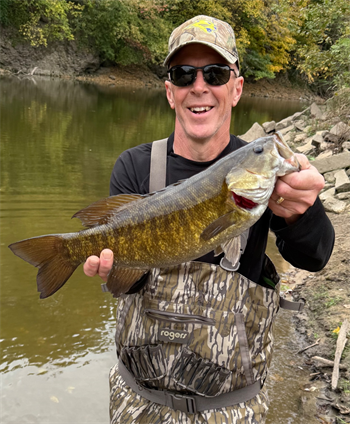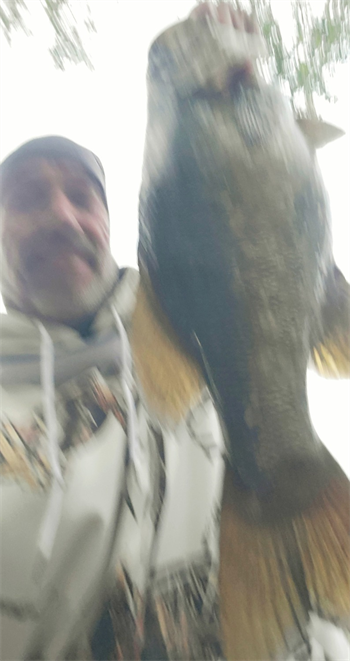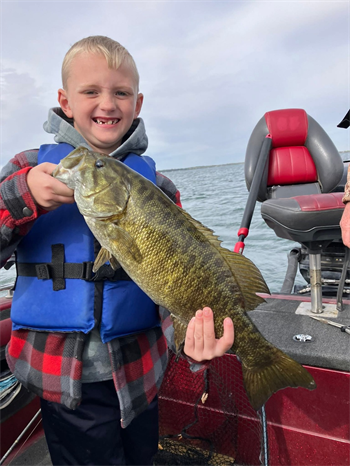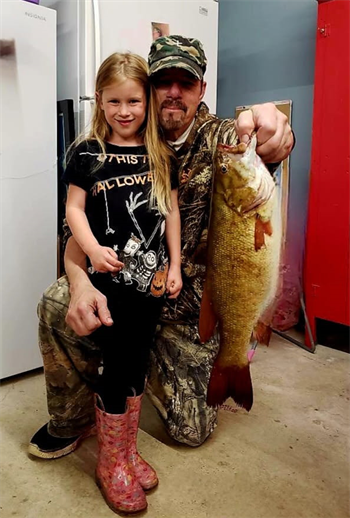Fish Iowa - Fish Species - Smallmouth Bass
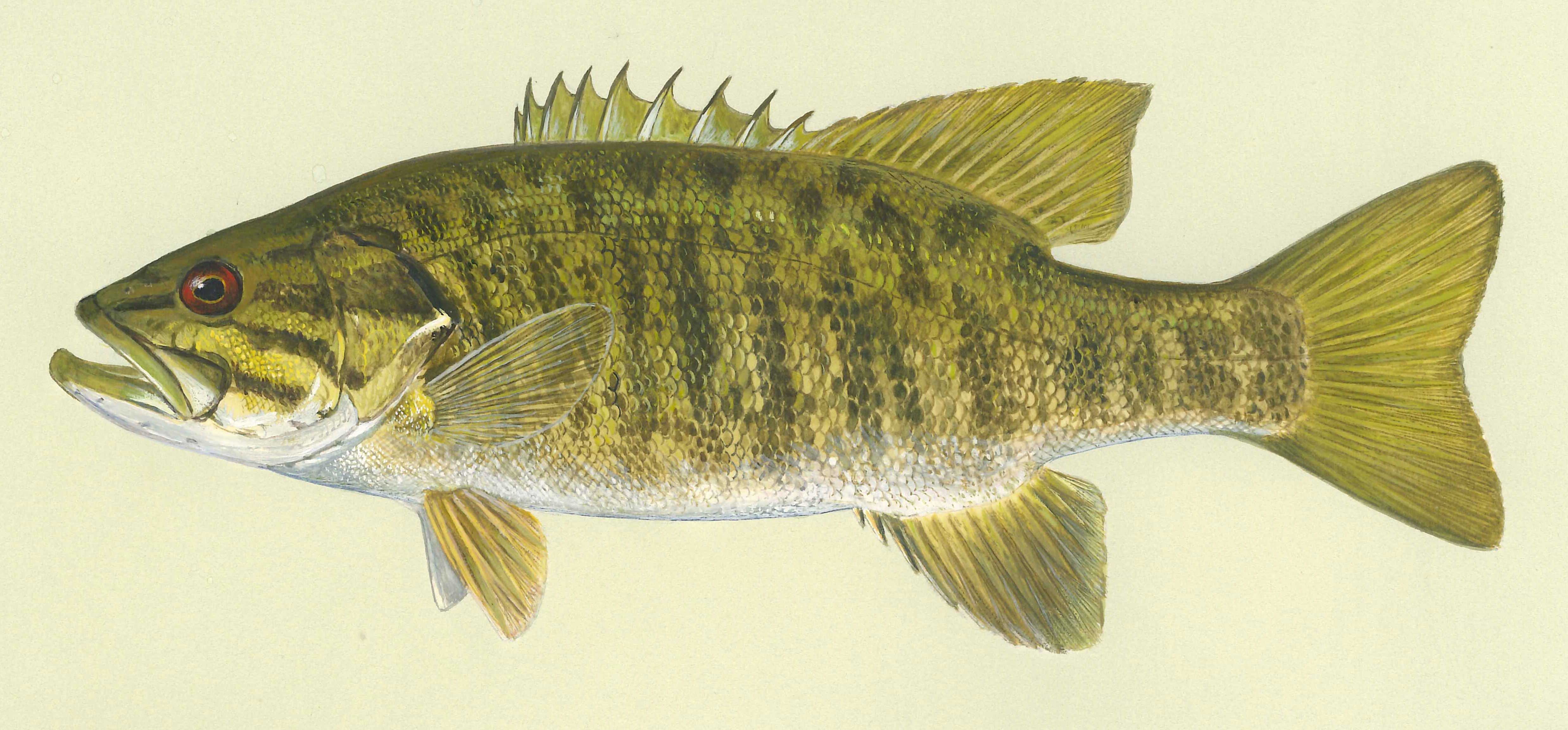
Characteristics
A slender, streamlined-shaped fish with a moderately large mouth, where the upper jaw reaches about to the rear margin of the eye in adults. Spiny and soft parts of the dorsal fin are broadly connected with only a shallow notch between the lobes. The body is golden green on the sides and back with faint wavy olive blotches evenly spaced along the sides. Five olive-green bars radiate backward from the eye, and one forward to the end of the snout. The tail fin in young smallmouth is tri-colored with a black vertical bar separating the yellowish fin base. Pyloric caeca are not forked in contrast to forked pyloric caeca in the closely related Largemouth Bass.
Foods
- No results found
Expert Tip
Use light spinning gear with crayfish colored crankbaits for hot smallmouth action.
Details
Smallmouth Bass are omnivorous in the food they eat. In the larger cool, clear interior streams of northeast Iowa, Smallmouth Bass is the dominant predator, eating mostly fish, crustaceans and larger aquatic and terrestrial insects. Food habit studies show that forage fish were in 40 percent of the stomach samples, crayfish in 30 percent and insects in 20 percent. Where crayfish are abundant, they often make up over two-thirds of the food. Newly hatched smallmouth eat copepods and cladocerans, but start to eat insects when about one-half inch long. When fingerling Smallmouth Bass are 1 1/2 inches long, insects and small fish make up the bulk of their diet.
Smallmouth Bass spawn in Iowa in early May as water temperatures exceed 60 degrees. To prepare for spawning, parent spawners move up larger streams, eventually reaching small tributaries where the actual spawning happens. Male fish build a saucer-shaped nest on the gravel, coarse sand or rock bottom by sweeping its tail over the substrate. The 14- to 25-inch diameter nest is found in quiet water near the shoreline downstream from a boulder or other natural structure that deflects and slows the current.
The ripe male bass selects a gravid female after the nest is built and nudges her toward the nest in a series of aggressive body contacts and bites. If the female refuses the nest, the male becomes more aggressive until the female is physically driven over the depression. Both fish lie side by side, facing the same direction during the release of eggs as the female vibrates her body by muscle action. The male releases milt for fertilization as the eggs are deposited. The female leaves the nest after spawning, but may return later to the same nest or another if she has hidden egg development. Male fish usually ripen again after a short time. Male fish protect the nest from predators and fan the eggs free of silt until the sac fry emerge in 3 to 5 days, depending on water temperature. Re-nesting is common for smallmouth, mainly when early nests are destroyed by natural events such as a flood.
The number of eggs a female Smallmouth Bass lays varies greatly depending on body size. Average is 7,000 to 8,000 eggs per pound of body weight. Newly hatched sac fry swim over the nest in a school for about 6 to 15 days, moving sluggishly until all the nourishment in the yolk sac is eaten. The young fry are about one-half inch long when the yolk sac is absorbed, and they leave the nest to eat small crustaceans and copepods.
Smallmouth Bass growth varies with the amount of food eaten and water temperature. Most Smallmouth Bass in Iowa reach 3- to 5-inches by the first autumn, 6- to 7-inches in the second year, and 9- to 10-inches the third year. Smallmouth sexually mature in the second or third year of life, but where food is scarce or water is relatively cool in all seasons, maturation may not occur until the third or fourth year. Maximum weights of 6- or 7-pounds have been reported in Iowa, but fish over 3- to 4-pounds are trophy sized.
Recent stream sampling information is available from Iowa DNR's biological monitoring and assessment program.
Learn more about this fish at the Smallmouth Bass Profile DNR Homepage
Distribution Map

Northeastern 2/3 of Iowa in clear rivers, streams and some lakes; most abundant in northeast Iowa.
See our most recent distribution data for this species on the Iowa DNR's Bionet application.
Fish Surveys
Tip: Click Species Length by Site, then use the dropdown to filter by fish species of interest.Where this Fish Is Found
Bear Creek
Big Creek Lake
Big Lake (Lansing)
Big Sioux River
Bloody Run Creek
Canoe Creek
Cedar River (above Nashua)
Cedar River (Cedar Rapids to Moscow)
Cedar River (La Porte City to Cedar Rapids)
Cedar River (Nashua to La Porte City)
Center Lake
Charles City Impoundment
Coralville Reservoir
Dakins Lake
Des Moines River (Saylorville to Red Rock)
Des Moines River (Stratford to Saylorville Lake)
East Fork Des Moines (Algona to Humboldt)
East Okoboji Lake
Elkader Impoundment
Frenchtown Lake
Gimmel Lake
Iowa River (above Iowa Falls)
Iowa River (Coralville Lake to River Junction)
Iowa River (Iowa Falls to Marshalltown)
Iowa River (Marshalltown to Coralville Lake)
Lake Delhi
Lidtke Impoundment
Little Spirit Lake
Lylah's Marsh County Park
Manchester Impoundment
Maquoketa River (above Monticello)
Maquoketa River (below Monticello)
Martelle Lake
Middle Raccoon River (above Redfield confluence)
Mink Creek
Minnewashta Lake
Missouri River (Council Bluffs to state line)
Missouri River (Little Sioux to Council Bluffs)
Missouri River (Sioux City to Little Sioux)
Mohawk Park Lake
Nashua Impoundment (Cedar Lake)
New Albin Big Lake
North Raccoon River (above Auburn)
North Raccoon River (Perry to Van Meter)
Otranto Impoundment
Paint Creek
Pleasant Creek Lake
Pool 09, Mississippi River
Pool 11, Mississippi River
Pool 12, Mississippi River
Pool 13, Mississippi River
Pool 14, Mississippi River
Pool 15, Mississippi River
Pool 16, Mississippi River
Pool 17, Mississippi River
Pool 18, Mississippi River
Pool 19, Mississippi River
Prairie Park Fishery
Rock River
Scharnberg Pond
Seminole Valley Park Lakes
Shell Rock River (above Greene)
Shell Rock River (Greene to Shell Rock)
South Skunk River (Cambridge to Pella)
South Skunk River (Story City to Cambridge)
Spirit Lake
Tete des Morts River
Turkey River
Turkey River (above Clermont)
Turkey River (below Clermont)
Twelve Mile Creek Lake
Upper Dam Impoundment
Upper Iowa River (above Decorah)
Upper Iowa River (below Decorah)
Volga River
Wapsipinicon River (Oxford Junct to Mississippi R)
Wapsipinicon River (Tripoli to Troy Mills)
Wapsipinicon River (Troy Mills to Oxford Junction)
Waucoma Impoundment
West Fork Cedar River
West Fork Des Moines (Emmetsburg to Humboldt)
West Okoboji Lake
Winnebago River
Yellow River (Trout Section)
Stocking
10/25/2023 - Wapsipinicon River (Troy Mills to Oxford Junction): 4542 (size: 2.4)
6/15/2023 - Wapsipinicon River (Troy Mills to Oxford Junction): 3008 (size: 4)
10/7/2022 - Middle Sabula Lake: 150 (size: 6)
6/22/2022 - Pleasant Creek Lake: 3080 (size: 2)
7/9/2021 - Iowa River (Coralville Lake to River Junction): 5246 (size: 2.9)
7/9/2021 - Wapsipinicon River (Troy Mills to Oxford Junction): 5486 (size: 2.8)
6/25/2021 - Pleasant Creek Lake: 2100 (size: 3)
6/25/2021 - Pleasant Creek Lake: 10 (size: Adult)
6/18/2021 - Pleasant Creek Lake: 4928 (size: 1.3)
4/19/2021 - Iowa River (Coralville Lake to River Junction): 1000 (size: 4.9)
9/25/2020 - Middle Sabula Lake: 1866 (size: 4.8)
9/25/2020 - Iowa River (Coralville Lake to River Junction): 1249 (size: 1.7)
6/24/2020 - Pleasant Creek Lake: 8000 (size: 1.3)
6/24/2020 - Pleasant Creek Lake: 10 (size: Adult)
7/3/2019 - Pleasant Creek Lake: 12 (size: Adult)
7/3/2019 - Pleasant Creek Lake: 5145 (size: 2)
7/3/2018 - Pleasant Creek Lake: 2923 (size: 1.5)
5/24/2018 - Wapsipinicon (Troy Mills to Oxford Junction): 1085 (size: 3)
7/7/2017 - Pleasant Creek Lake: 10 (size: Adult)
7/7/2017 - Pleasant Creek Lake: 1540 (size: 1.8")
6/12/2017 - Pleasant Creek: 9 (size: 14" - 18")
5/9/2017 - Pleasant Creek: 18 (size: 12" - 18")
4/12/2017 - Pleasant Creek: 20 (size: 15" - 19")
11/4/2013 - Wapsipinicon River: 2700 (size: 3.0")
4/28/2010 - Iowa River: 1070 (size: 5.2")
4/26/2010 - Farmers Creek: 500 (size: 4.2")
7/10/2008 - Twelve Mile: 10028 (size: 2.0")
6/29/2006 - Cedar River (La Porte City to Cedar Rapids): 9000 (size: 1.6")
6/29/2006 - Iowa River (Coralville Lake to River Junction): 10000 (size: 1.6")
6/29/2006 - Rock River: 5000 (size: 1.6")
6/29/2006 - Brushy Creek: 10000 (size: 1.6")
6/28/2006 - Three Mile: 12500 (size: 1.6")
6/28/2004 - Iowa River (Coralville Lake to River Junction): 23000 (size: 2")
6/28/2004 - Wapsi River (Troy Mills to Oxford Junction): 1551 (size: 2")
7/2/2003 - Des Moines River (Humboldt to Stratford): 3800 (size: 2")
8/15/2002 - Middle Raccoon River (above Van Meter): 9804 (size: 3.5")
8/15/2002 - East Fork Des Moines (state line to Algona): 2000 (size: 3.5")
8/15/2002 - Brushy Creek: 2916 (size: 3.5")
10/18/2001 - Brushy Creek: 1120 (size: 5")
10/17/2001 - Three Mile: 1295 (size: 5")
9/20/2001 - Big Creek: 1500 (size: 4.9")
8/3/2001 - Middle Raccoon River (above Van Meter): 5000 (size: 2")
8/3/2001 - South Skunk River (Story City to Cambridge): 5000 (size: 2")
8/3/2001 - Three Mile: 6000 (size: 2")
8/3/2001 - Brushy Creek: 5000 (size: 2")
10/14/1999 - Brushy Creek: 2340 (size: 5")
10/7/1999 - Three Mile: 1550 (size: 5")
7/27/1999 - Brushy Creek: 7500 (size: 2")

